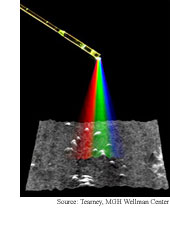
|
October
31/
November 6, 2006
 |
|
|  |
|
NEWS
|
Speaking
antibiotic
Modeling amino acid sequences as a language allows
scientists to create new forms of antimicrobial peptides
-- small proteins that hinder bacterial growth and reproduction.
The artificial antimicrobial peptides promise to foster
antibacterial drugs that are less susceptible to bacterial
resistance than today's antibiotics. (A
Linguistic Model for the Rational Design of Antimicrobial
Peptides, Nature, October 19, 2006)
3D mini endoscope
 An endoscope made of a single, hair-like optical
fiber uses multicolored light to make three-dimensional
video scans of areas inside the body. The medical imaging
device is smaller and more flexible than today's endoscopes,
promising access to smaller and more delicate areas of
the body. (Three-Dimensional
Miniature Endoscopy, Nature, October 19, 2006)
An endoscope made of a single, hair-like optical
fiber uses multicolored light to make three-dimensional
video scans of areas inside the body. The medical imaging
device is smaller and more flexible than today's endoscopes,
promising access to smaller and more delicate areas of
the body. (Three-Dimensional
Miniature Endoscopy, Nature, October 19, 2006)
Hyper MRI
Specially designed molecules that contain xenon
atoms promise magnetic resonance imaging 10,000 times
more sensitive than today's MRIs. The technique could
be used to target specific tissues in the body like heart
muscle and to detect individual molecules like proteins
that signal heart disease. (Molecular
Imaging Using a Targeted Magnetic Resonance Hyperpolarized
Biosensor, Science, October 20, 2006)
Nano cure for bad oxygen
Cerium oxide nanoparticles reduced vision loss
in rats by disposing of toxic oxygen-based molecules and
ions. The nanoparticles promise to prevent cell death
in a range of diseases, including macular degeneration,
diabetes, Alzheimer's and atherosclerosis. (Rare
Earth Nanoparticles Prevent Retinal Degeneration Induced
by Intracellular Peroxides, Nature Nanotechnology,
November 2006)
Less chilly single photons
Microscopic specks of gallium nitride embedded
in aluminum nitride can be triggered to emit single photons
at a temperature as high as -73 degrees Celsius. The device
could lead to practical sources of single photons, which
promise to increase the speed of quantum cryptography
communications systems. (A
Gallium Nitride Single-Photon Source Operating at 200K,
Nature Materials, published online October 22,
2006)
Quantum synchronized swimming
A pair of memory devices emit single photons at
the same time, bringing networks that can pass along information
stored in individual atoms a step closer. Quantum networks
can be used to connect quantum computers, which tap properties
of atoms and subatomic particles to compute, and quantum
cryptography networks, which use such properties to transfer
information securely. (Conditional
Control of the Quantum States of Remote Atomic Memories
for Quantum Networking, Nature Physics, December
2006) |
FEATURES
|
View
from the High Ground: ICL's John Pendry
Physics as machine tool, negative refractive
index, metamaterials, shattered wine glasses, higher capacity
DVDs, scientific backwaters, risk perception and practice,
practice, practice.
|
How
It Works: Quantum computing: qubits
Photons, electrons and atoms, oh my! These particles are
the raw materials for qubits, the basic building blocks
of quantum computers. |
|
 |
News RSS feed 
Blog RSS feed 
Bookshelf RSS feed

New: TRN's
Internet Services
TRN's Jobs Center
|
| |
|
| |
|
| |
"Physics
is to the rest of science what machine tools are
to engineering. A corollary is that science places
power in our hands which can be used for good or
ill. Technology has been abused in this way throughout
the ages from gunpowder to atomic bombs."
- John Pendry, Imperial College London |
|
| |
|
| |
Thanks
to Kevin from
GoldBamboo.com
for technical support |
|

